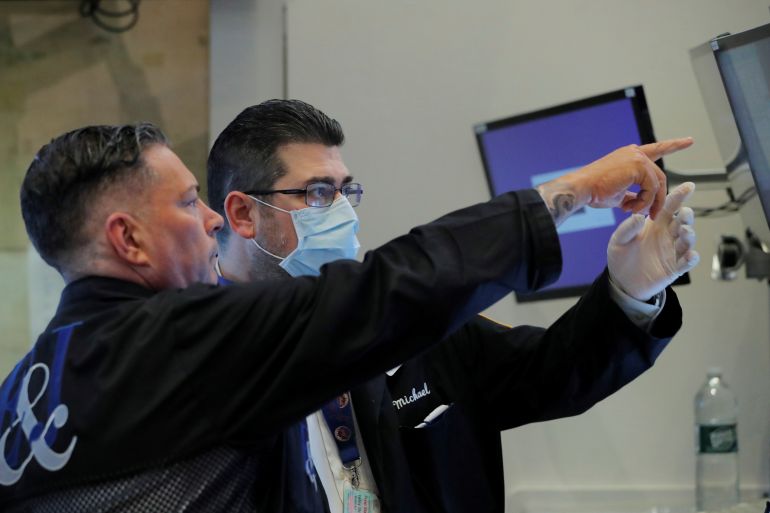Wall Street ends 1% lower after Trump calls off relief talks
All three major US stock indexes closed more than 1 percent lower following Trump’s tweets Tuesday.

US stocks ended down more than 1 percent on Tuesday after President Donald Trump said he was calling off negotiations with Democratic legislators on coronavirus relief legislation until after the November 3 election.
Stocks were higher before the remarks, but reversed course after Trump made the comments on Twitter.
Keep reading
list of 4 itemsUS stocks flat as Fed’s Powell urges more federal virus aid
US stocks sink after Trump tests positive for COVID-19
US stocks tick higher as virus aid deal uncertainty rules
The S&P 500 fell to a session low shortly after the tweet, taking the index down more than 2 percent from its session high. Airline shares also tumbled, with United Airlines ending down 3.6 percent on the day, and the Cboe Volatility index climbed to a session high.
“Much of the rally we’ve seen in the last week in particular was based on hopes for an additional stimulus package,” said Robert Phipps, director at Per Stirling Capital Management in Austin, Texas. “There’s now a whole lot less reason to put money to work before the election.”
Cases of the virus are still on the rise across much of the country, and hopes that a stimulus deal was still possible had helped stocks to recoup recent losses sparked by the news that Trump had contracted COVID-19.
The Dow Jones Industrial Average fell 375.88 points, or 1.34 percent, to 27,772.76, the S&P 500 lost 47.66 points, or 1.40 percent, to 3,360.97 and the Nasdaq Composite dropped 177.88 points, or 1.57 percent, to 11,154.60.
“Clearly, the markets were pricing in some possibility of stimulus,” said Chris Zaccarelli, chief investment officer at Independent Advisor Alliance in Charlotte, North Carolina.
But, he said, it was probably unlikely legislators would have reached a compromise with their current proposals.
Earlier in the session, Federal Reserve Chair Jerome Powell warned that the US economic recovery remained far from complete.
Powell said the domestic rebound could still slip into a downward spiral if the coronavirus is not effectively controlled and growth sustained.
Consumer discretionary shares were among the biggest weights on the S&P 500, with the sector falling 2.1 percent on the day, but most of the major sectors were down at least 1 percent.
Declining issues outnumbered advancing ones on the NYSE by a 1.54-to-1 ratio; on Nasdaq, a 1.37-to-1 ratio favored decliners.
The S&P 500 posted 31 new 52-week highs and no new lows; the Nasdaq Composite recorded 114 new highs and 17 new lows.
Volume on US exchanges was 10.55 billion shares, compared with the 9.79 billion average for the full session across the last 20 trading days.
Outside of the US, the pan-European STOXX 600 index rose 0.07 percent and MSCI’s gauge of stocks across the globe shed 0.75 percent.
Crude prices extended gains, boosted by supply disruptions from approaching storms in the Gulf of Mexico and a continuing oil worker strike in Norway.
US crude futures settled at $40.67 per barrel, a gain of 3.7 percent, while Brent gained 3.29 percent on the day to settle $42.65 per barrel.
The dollar, essentially flat for much of the session, jumped against a basket of world currencies after Trump’s tweet.
The dollar index rose 0.21 percent, with the euro down 0.27 percent to $1.1749.
The Japanese yen strengthened 0.14 percent versus the greenback at 105.62 per dollar, while Sterling was last trading at $1.2902, down 0.58 percent on the day.
US Treasury yields dropped from four-month peaks after Trump’s announcement.
Benchmark 10-year notes last rose 5/32 in price to yield 0.7469 percent, from 0.762 percent late on Monday.
The 30-year bond last rose 13/32 in price to yield 1.5501 percent, from 1.567 percent late on Monday.
Gold prices were lower after the safe-haven precious metal erased earlier gains.
Spot gold dropped 1.4 percent to $1,886.71 an ounce.